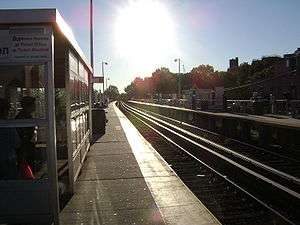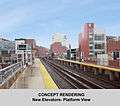Flushing–Main Street (LIRR station)
Flushing–Main Street | ||||||||||||
|---|---|---|---|---|---|---|---|---|---|---|---|---|
 View from Eastbound Platform "B" to Port Washington | ||||||||||||
| Location |
Main Street & 41st Avenue Flushing, New York | |||||||||||
| Coordinates | 40°45′29″N 73°49′52″W / 40.757989°N 73.831086°WCoordinates: 40°45′29″N 73°49′52″W / 40.757989°N 73.831086°W | |||||||||||
| Owned by | Long Island Rail Road | |||||||||||
| Line(s) | ||||||||||||
| Platforms | 2 side platforms | |||||||||||
| Tracks | 2 | |||||||||||
| Connections |
New York City Subway: | |||||||||||
| Construction | ||||||||||||
| Parking | Yes (metered) | |||||||||||
| Other information | ||||||||||||
| Fare zone | 3 | |||||||||||
| History | ||||||||||||
| Opened | June 26, 1854 (NY&F)[1] | |||||||||||
| Rebuilt | 1865, 1870, 1913, 1958 | |||||||||||
| Electrified |
October 22, 1912 750 V (DC) third rail | |||||||||||
| Previous names | Flushing (1853-1870) | |||||||||||
| Traffic | ||||||||||||
| Passengers (2006) | 2,136[2] | |||||||||||
| Services | ||||||||||||
| ||||||||||||
Flushing–Main Street is a station on the Port Washington Branch of the Long Island Rail Road, serving the neighborhood of Flushing, Queens. The station is part of CityTicket, and is in Zone 3. The station is located at Main Street and 41st Avenue, off Kissena Boulevard and is 9.5 miles (15.3 km) from Penn Station in Midtown Manhattan and 10.4 miles (16.73 km) southwest of Port Washington. Parking is provided at a municipal lot on 41st Avenue.
History
The Flushing–Main Street station was originally built in December 1853 as "Flushing" station by the New York and Flushing Railroad, but not opened until June 26, 1854. Flushing would serve as the terminus of the NY&F until October 30, 1864 when a subsidiary known as the North Shore Railroad extended it out to Great Neck, and it was burned in order to prepare for a second station that was built between January and February 1865. In 1868, the station and the rest of the line were acquired by the Flushing and North Side Railroad, which razed the station again in 1870 and built a third station between October and November 1870. The station was renamed after both Flushing and Main Street, in order to distinguish itself from the former Flushing Bridge Street station that ran along the F&NS's Whitestone Branch, which was later abandoned by the LIRR in 1932.
Throughout the mid-1870s, the station and the rest of the line was merged with the Central Railroad of Long Island to form the Flushing, North Shore and Central Railroad, and finally became part of the Port Washington Branch of the Long Island Rail Road, which also used the station as the eastern terminus of the White Line between 1873 and 1876. Shortly after the line was electrified on October 22, 1912, the station was abandoned on November 11, 1912, as part of an effort by the Long Island Rail Road to bring the Port Washington Branch above and below street level depending on the location.
In Flushing, the station was elevated along with the rest of the tracks on October 4, 1913. Until that point, the line used to run at grade and went through a tunnel under a girls' school just east of where the Main Street overpass stands today.[3] The tunnel and the school were torn down to build the overpass and the open cut the line now runs through. In 1958, the elevated track level building was razed and replaced with a street level ticket office. Sheltered platforms exist on both sides of the tracks in the former station's place, and the sidewalks beneath the bridge serve as local businesses.
Platforms and tracks
| 1 | ■ Port Washington Branch | toward Penn Station (Mets–Willets Point game days; Woodside other times) |
| 2 | ■ Port Washington Branch | toward Port Washington (Murray Hill) |
The station has two high-level side platforms, each 10 cars long. The north platform next to Track 1, is generally used by westbound or Manhattan-bound trains. The south platform next to Track 2, is generally used by eastbound or Nassau County-bound trains. The branch has two tracks here.
Planned improvement
The Metropolitan Transportation Authority is planning to renovate the station and bring it into compliance with the 1990 Americans With Disabilities Act. An official description of the $24.6 million project states:
The Project will include construction of two new elevators, one from each of the two platforms, to provide ADA accessibility from the street to the platforms at the Flushing Main Street Station. The work also will include a new ticket office, canopies, new stairs, platform railings, and platform lighting. Acquisition of the Property is needed to demolish the existing one-story commercial building in order to construct the elevator serving the westbound train platform that will be accessible from the west side of Main Street. This entrance will provide a safer, more visible entry point for westbound LIRR customers than the current entrance in an alley off of 40th Road and the Project as a whole will enhance LIRR's presence on Main Street.[4]
On October 28, 2013, the MTA held a public hearing on the proposed acquisition of private property at 40-36 Main Street in Flushing for the purpose of adding an elevator intended for the rebuilt station. By June 2015, design had been completed and one of the two parcels of private property, a food stall, had been acquired. MTA expected to complete the eminent domain acquisition of Ou-Jang Supermarket's 40-36 Main Street property by summer 2015; the supermarket objected to the amount MTA offered, $974,592. On January 6, 2016, filings in Queens County Superior Court showed that MTA and the supermarket reached a settlement of $2,236,600, of which $1.9 million was the cash purchase price and the remainder represented rent to be paid by MTA on behalf of the supermarket at its new location.[5] The MTA began in July 2016 and to complete the project by 4 quarter of 2017.[6] As of December 2015, the MTA had put the project out for competitive bidding with a proposal due date of December 9, 2015.[7]
On July 22, 2016, the ticket office was closed as part of the two-year renovation project along with the staircase to the eastbound platform with a temporary staircase and platform extension providing access.[8][9] The current staircase to the city-bound platform will be closed for renovation upon the opening of a new staircase and elevator.[10]
Gallery
 Rendering for planned elevator at Flushing station. (street view)
Rendering for planned elevator at Flushing station. (street view) Rendering for planned elevator at Flushing station. (platform view)
Rendering for planned elevator at Flushing station. (platform view) Bombardier M7 7799 at the Flushing station.
Bombardier M7 7799 at the Flushing station. 1891 Station Map.
1891 Station Map. The current station house, almost underneath the bridge.
The current station house, almost underneath the bridge. Street vendor selling fruit under the station.
Street vendor selling fruit under the station.
References
- ↑ Vincent F. Seyfried, The Long Island Rail Road: A Comprehensive History, Part Two: The Flushing, North Shore & Central Railroad, © 1963
- ↑ Average weekday, 2006 LIRR Origin and Destination Study
- ↑ October 12, 1913 image of Water Tank & Tunnel @ Flushing Station by Vincent Seyfried and Asadorian (TrainsAreFun.com)
- ↑ "Public Hearing: LIRR Flushing Main Street Station Improvement Project". Metropolitan Transportation Authority. Retrieved October 31, 2013.
- ↑ Toure, Madina (February 12, 2016). "MTA settles Flushing LIRR eminent domain case". Times Ledger.
- ↑ Toure, Madina (June 24, 2015). "Flushing LIRR station project to be completed by 2017: MTA". Times Ledger.
- ↑ "Current Solicitations". MTA LIRR. Metropolitan Transportation Authority. 2016-06-29. Retrieved 2016-09-17.
- ↑ "MTA LIRR - Flushing Main Street". lirr42.mta.info. Retrieved 2016-09-16.
- ↑ "Flushing-Main Street Station Ticket Office Closure Effective Friday". web.mta.info. Retrieved 2016-09-16.
- ↑ "MTA LIRR - Flushing Main Street Station Improvement Project". web.mta.info. Retrieved 2016-09-16.
External links
| Wikimedia Commons has media related to: |
- Official LIRR station information page for Flushing–Main Street
- Station timetable for Flushing–Main Street
- Unofficial LIRR Website Photos.
- Main Street entrance from Google Maps Street View
- Platforms from Google Maps Street View